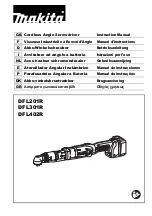
English
2
CAUTION: Wear appropriate hearing protection during use.
Under some condi-
tions and duration of use, noise from this product may contribute to hearing loss.
WARNING:
Some dust created by power sanding, sawing, grinding, drilling, and other
construction activities contains chemicals known to cause cancer, birth defects or other
reproductive harm. Some examples of these chemicals are:
• lead from lead-based paints,
• crystalline silica from bricks and cement and other masonry products, and
• arsenic and chromium from chemically-treated lumber (CCA).
Your risk from these exposures varies, depending on how often you do this type of work.
To reduce your exposure to these chemicals: work in a well ventilated area, and work with
approved safety equipment, such as those dust masks that are specially designed to filter
out microscopic particles.
Avoid prolonged contact with dust from power sanding, sawing, grinding,
drilling, and other construction activities. Wear protective clothing and wash
exposed areas with soap and water.
Allowing dust to get into your mouth, eyes, or lay
on the skin may promote absorption of harmful chemicals.
• The label on your tool may include the following symbols.
V................volts
A....................amperes
Hz..............hertz
W ..................watts
min ............minutes
................alternating current
..........direct current
no ..................no load speed
..............Class II Construction
....................
earthing terminal
..............safety alert symbol
.../min ............revolutions per minute
Switch
To start tool, depress the trigger switch, shown in Figure 1. To
stop tool, release the switch. The variable speed trigger switch
permits speed control. The farther the trigger switch is depressed,
the higher the speed of the tool.
To lock the switch in the on position for continuous operation,
depress the trigger switch and push up the locking button. The
tool will continue to run. To turn the tool off, from a locked on
condition, squeeze and release the trigger once. Before using
the tool (each time), be sure that the locking button release
mechanism is working freely. Be sure to release the locking
mechanism before disconnecting the plug from the power
supply. Failure to do so will cause the tool to start immediately
the next time it is plugged in. Damage or injury could result.The
reversing lever is used to reverse the tool for backing out screws. It is
located above the trigger, shown in Figure 1. To reverse the
screwdriver, turn it off and push the reversing lever to the right (when
viewed from the back of the tool). To position the lever for forward
operation, turn the tool off and push the lever to the left.
Dead Spindle Action
All D
E
WALT screwdrivers provide a dead output spindle to permit fasteners to be located
easily in the driving accessory. Clutches are held apart by light spring pressure permitting
the driving clutch to rotate without turning the driven clutch and accessory. When sufficient
forward pressure is applied to the unit, the clutches engage and rotate the spindle and
accessories. A reversing switch makes it possible to drive or loosen either right or left hand
screws.
220 VOLT
FIG. 1
Accessory Assembly
The 1/4" hex drive ball lock chuck is used on all depth sensitive and drywall screwdrivers.
Assemble accessories by engaging the hex spindle and tapping lightly on the accessory
until it snaps in place. Usually pliers are required to remove the
accessory by pulling forward. The 1/4" hex drive quick change
chuck (Figure 2), is used on all Versa Clutch™ units. A ball
retainer provides positive locking of all accessories in the
chuck. Pull forward on the ball retainer and hold while inserting
or removing accessories. Release for positive accessory
retention.
Depth Sensitive Units
(DW251, DW252, DW255, DW257,
DW262, DW265, DW272, DW274,
DW274W, DW274-220, DW276, DW276-220)
TO CHANGE BIT HOLDERS
1. Pull forward on adjustment collar and remove from clutch housing.
2. Pull bit holder straight out with pliers if it is difficult to remove.
3. Push new bit holder into spindle until ball lock snaps in groove in bit holder shank.
4. Replace adjustment collar by snapping over retaining ring.
NOTE:
Align ribs on inside of depth locator with grooves in clutch housing before snapping
into place.
CHANGING BIT TIP
1. Pull forward on adjustment
collar and remove it from
clutch housing (see Figure 3).
2. Use pliers to remove worn bit
and install new bit tip.
DEPTH ADJUSTMENT
Follow the graphic on the collar to increase or decrease the fastening depth. To seat the
screw deeper in the workpiece, turn the adjustment collar to the right. To seat the screw
higher in the workpiece, turn the adjustment collar to the left.
Nutsetting Units
(DW260, DW263, DW266, DW266-220)
INSTALLING AND CHANGING NUTSETTERS AND LOCATORS
Depth Sensitive Units for Drill Point Screws
1. To change or install a new nutsetter:
a) Pull forward on adjustment collar and remove from clutch
housing.
b) Pull nutsetters straight out with pliers.
c) Select nutsetter size desired.
d) Two locators are supplied, a 9/16" ID for 3/8" nutsetters
and 1/2" ID for 5/16" nutsetters. Match locator to desired
size nutsetter or bit holder.
2. Place nutsetter into clutch housing and push end of nutsetter
until ball lock snaps into groove of nutsetter shank.
3. Reassemble adjustment collar by snapping over springs
(see Figure 4).
NOTE
: Align ribs on inside of depth locator with grooves in clutch
housing.
FIG. 4
NUTSETTER
FIG. 3
FIG. 2


































